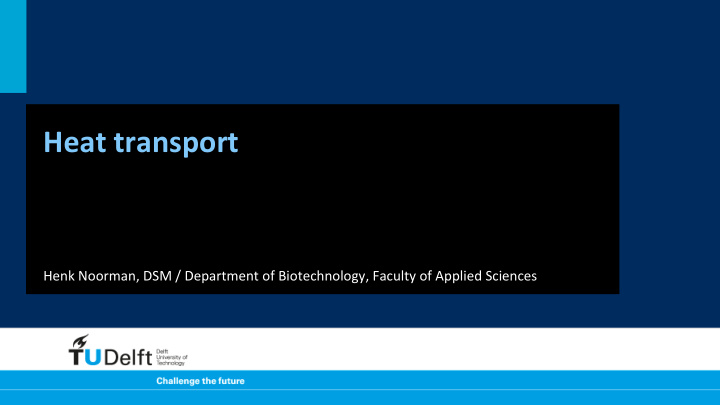



Heat ¡transport ¡ Henk ¡Noorman, ¡DSM ¡/ ¡Department ¡of ¡Biotechnology, ¡Faculty ¡of ¡Applied ¡Sciences ¡ ¡
One ¡of ¡four ¡limi1ng ¡transport ¡steps: ¡Heat ¡removal ¡ Liquid ¡ Offgas ¡ feedstock ¡ Air ¡ Broth ¡ou>low ¡
Heat ¡sources ¡and ¡sinks ¡in ¡a ¡fermenter ¡ EvaporaJon ¡ In ¡aerobic ¡processes ¡usually ¡surplus ¡of ¡ Hot ¡feed ¡ heat ¡generated ¡of ¡several ¡MW ¡(MJ/s) ¡ ¡ ¡ ReacJon ¡heat ¡ This ¡needs ¡to ¡be ¡transferred ¡to ¡ ¡ cooling ¡water ¡via: ¡ Cooling ¡water ¡ ¡ • Cooling ¡coil ¡ • Vessel ¡wall ¡ SJrrer ¡power ¡input ¡ • Cooling ¡baffles ¡ • Heat ¡exchanger ¡in ¡external ¡loop ¡ Hot ¡gas ¡
Transport ¡path ¡of ¡heat ¡removal ¡using ¡coils ¡(1) ¡ Internal ¡coil ¡ External ¡coil ¡
Transport ¡path ¡of ¡heat ¡removal ¡using ¡coils ¡(2) ¡ F cw,out ¡ 3 ¡steps ¡in ¡the ¡removal ¡heat ¡path ¡ 3 T cw,out ¡ ¡ Step ¡1. ¡Convec1on ¡ COIL ¡ ¡ ¡ ¡ ConvecJon ¡in ¡broth ¡ ¡ 1 2 Step ¡2. ¡Transfer ¡ ¡ F cw,in ¡ ¡ ¡Heat ¡transfer ¡through ¡coil: ¡ ¡ ¡ ¡ T cw,in ¡ ¡ ¡Coil ¡outside ¡boundary ¡layer ¡ à ¡Coil ¡ ¡ à ¡ ¡ ¡ ¡Coil ¡inside ¡boundary ¡layer ¡ BROTH ¡ ¡ Step ¡3. ¡Convec1on ¡ ¡ ¡ConvecJon ¡in ¡cooling ¡water ¡
Transport ¡path ¡of ¡heat ¡removal ¡using ¡coils ¡(2) ¡ F cw,out ¡ Two ¡important ¡terms: ¡ 3 T cw,out ¡ ¡ Heat ¡transfer ¡coefficient: ¡ COIL ¡ U ¡ ¡ ¡ 1 2 F cw,in ¡ m 2 ¡cooling ¡area ¡ ¡ ¡ T cw,in ¡ ¡ Heat ¡capacity ¡of ¡cooling ¡fluid: ¡ ¡ ρ ¡c p ¡ BROTH ¡ ¡ m 3 ¡cooling ¡fluid ¡ ¡ ¡ ¡
Transport ¡path ¡of ¡heat ¡removal ¡using ¡coils ¡(3) ¡ F cw,out ¡ Step ¡1 ¡ ConvecJve ¡heat ¡transport ¡in ¡broth ¡ ¡ T cw,out ¡ ¡ Are ¡there ¡temperature ¡gradients? ¡ ¡ COIL ¡ No! ¡ ¡ ¡ 1 F cw,in ¡ Temperature ¡T broth ¡only ¡varies ¡by ¡ ± ¡0.2 ◦ C ¡ T cw,in ¡ ¡ BROTH ¡
Transport ¡path ¡of ¡heat ¡removal ¡using ¡coils ¡(4) ¡ Step ¡2 ¡and ¡3 ¡ How ¡do ¡they ¡relate? ¡ ¡ BROTH ¡ T broth ¡ U ¡ ¡ ¡ ¡ ¡ ¡ ¡ ¡ ¡ ¡ ¡ ¡ ¡ ¡ ¡ ¡ ¡ ¡ ¡ ¡ ¡ ¡ ¡ ¡ ¡ ¡ ¡ ¡ ¡ ¡ ¡ ¡ ¡ ¡ ¡ ¡ ¡ ¡ ¡ ¡ ¡ ¡ ¡ ¡ ¡ ¡ ¡ ¡ ¡ ¡ ¡ ¡ ¡ ¡ ¡ ¡ ¡ ¡ ¡ ¡ ¡ ¡ ¡ ¡coil ¡area ¡A T ¡ ¡ ¡ ¡ ¡ ¡ ¡ ¡ ¡ ¡ ¡ ¡ ¡ ¡ ¡ ¡ ¡ ¡ Transfer ¡(step ¡2) ¡ Convec1on ¡(step ¡3) ¡ COOLING ¡ FLUID ¡ ρ cw ¡ T cw,out ¡ F cw ¡ ρ cw ¡ T cw,in ¡ F cw ¡ x x + x Δ T x T x+x Δ L
Transport ¡path ¡of ¡heat ¡removal ¡using ¡coils ¡(5) ¡ Heat ¡transfer ¡capacity ¡through ¡coil ¡ = Convec1on ¡capacity ¡in ¡cooling ¡water ¡ ¡ St heat ¡ 0.1 ¡ 1 ¡ 10 ¡ Transfer ¡is ¡boWleneck ¡ Cooling ¡water ¡flow ¡is ¡boWleneck ¡ T cw,out = ¡T cw,in ¡ T cw,out = ¡T Broth ¡ ConvecJon ¡capacity ¡>> ¡Transfer ¡capacity ¡ ConvecJon ¡capacity ¡<< ¡Transfer ¡capacity ¡ Scale-‑up: ¡A T ¡ / ¡V L ¡= ¡4 ¡/ ¡T ¡will ¡get ¡too ¡small ¡ à ¡external ¡cooling ¡is ¡needed ¡
Transport ¡path ¡of ¡heat ¡removal ¡using ¡ external ¡cooling ¡loop ¡in ¡the ¡PDO ¡process ¡ Advantages ¡ Challenges ¡ T return ¡= ¡30°C ¡ Cold ¡shocks ¡ • ¡ Shear ¡stress ¡in ¡the ¡ Greater ¡design ¡ • • freedom ¡ pump ¡ Broth ¡mass ¡= ¡ Plate ¡Heat ¡Exchanger ¡ Faster ¡heat ¡ Oxygen ¡and ¡ • • 2250 ¡tonnes ¡ ¡ ¡ transfer ¡ substrate ¡depleJon ¡ 25 ¡m ¡ in ¡the ¡loop ¡ R p = ¡165 ¡000 ¡ Heat ¡= ¡51434 ¡kJ/s ¡ ¡ mol ¡PDO/h ¡ ¡ Heat ¡removal ¡capacity ¡[kJ/s] ¡= ¡F loop ¡ ρC p ¡(T broth ¡– ¡T return ) ¡ 35°C ¡ T broth ¡= ¡35°C ¡ F loop ¡= ¡2.46 ¡m 3 /s ¡
Heat ¡transfer ¡design ¡ • T ¡control ¡requires ¡good ¡heat ¡transfer ¡design ¡ • Process ¡reacJon: ¡450 ¡kJ ¡heat ¡produced/mol ¡O 2 ¡consumed ¡ • EvaporaJon: ¡some ¡cooling ¡ • Impeller ¡energy ¡dissipaJon: ¡10-‑30% ¡more ¡heat ¡ • Be ¡aware ¡of ¡hot ¡and ¡cold ¡spots ¡at ¡large ¡scale! ¡ • Sterilized ¡feeds/compressed ¡gas: ¡hot! ¡ • At ¡megascale ¡(>1000 ¡m 3 ) ¡need ¡for ¡external ¡loop ¡cooling ¡ ¡ • Cold ¡shock: ¡microbes ¡may ¡change ¡metabolic ¡network ¡fluxes ¡(e.g. ¡ through ¡temperature-‑induced ¡geneJc ¡switch ¡for ¡product ¡formaJon) ¡ • Oxygen ¡or ¡substrate ¡depleJon ¡in ¡the ¡external ¡loop ¡
See ¡you ¡in ¡the ¡next ¡unit! ¡
Recommend
More recommend